Philippine Army
The Philippine Army (PA) (Filipino: Hukbong Katihan ng Pilipinas; Spanish: Ejército Filipino) is the main, oldest and the largest branch of the Armed Forces of the Philippines (AFP) responsible for ground warfare. The Chief of the Army, its professional and overall head, is Lieutenant General Cirilito Sobejana, who took office on August 4, 2020. Its main headquarters is located at Fort Andres Bonifacio, Metro Manila.
History
After three centuries of Spanish rule there were calls for social reforms and an end to the perceived oppressive friar rule. In 1896, Andres Bonifacio founded the Katipunan to prepare his band of Filipinos for armed revolt against the Spanish government. The Katipunan formed an army of insurgents.
Almost a year after the outbreak of hostilities between the Katipuneros and the Spanish troops, Emilio Aguinaldo's newly formed the Philippine Revolutionary Government and its Army were officially born on March 22, 1897 at Tejeros, San Francisco de Malabon in Cavite. General Artemio Ricarte was named Captain General of the Ejercito en la Republica de las Islas Filipinas or the revolutionary Philippine Army. This date marks the founding day Philippine Revolutionary Army (PRA).
On June 12, 1898, General Emilio Aguinaldo declared Philippine Independence from Spain and formed the first Philippine Republic, in which he sat as its president. The Filipino troops were to enjoy only a brief respite from combat when American forces came in to establish rule in the islands by virtue of the Treaty of Paris, which Spain co-signed with America on December 10, 1898. The treaty ceded the Philippines to the United States.

Philippine–American War (1899–1902)
During the final years of the Philippine–American War, with the notable successes by the all-Filipino Macabebe Scouts cavalry squadron (raised in 1899) under U.S. command against the Philippine Revolutionary Army (PRA), the American President Theodore Roosevelt officially sanctioned the raising of the Philippine Scouts (PS) as part of the United States Army, with full effect starting from October 1901. Earlier, in August that same year, came the colonial civil government's decision to found the Philippine Constabulary (PC) as the national gendarmerie force for law enforcement. Both of these organizations and their victories over the PRA contributed to the official end of the conflict in 1902, even as resistance continued (inclusive of the Muslims of the south, resulting in the Moro Rebellion) through 1914.
Starting in 1910, Filipino personnel in the Philippine Scouts were sent to the United States Military Academy with one PS soldier being sent per year. Several of these graduates who served with the Scouts, plus PC officers, both formed part of the first officer corps of the revitalized Philippine Army established in 1935.
Commonwealth Period (1935–1946)
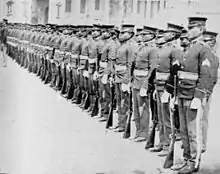
The Philippine Army of today was initially organized under the National Defense Act of 1935 (Commonwealth Act No. 1) that formally created the Armed Forces of the Philippines. The act specified that in so far as may be practicable, original appointments by the President in grades above third lieutenant should be made from among former holders of reserve commissions in the United States Army, from among former officers of the Philippine Scouts and Constabulary.[3][4]
After the establishment of the Philippine Commonwealth on November 15, 1935, President Manuel L. Quezon sought the services of General Douglas MacArthur to evolve a national defense plan. The official rebirth of the Philippine Army occurred with the passage of Commonwealth Act No. 1, approved on December 21, 1935, which effected the organization of a Council of National Defense and of the Army of the Philippines. The act set forth the organizational structure of the army in some detail, set forth enlistment procedures, and established mobilization procedures.[3] With this act, the AFP was officially established.
The development of the new Philippine Army was slow.[5] The year 1936 was devoted to the building of camps, organization of cadres, and the special training of instructors, drawn largely from the Constabulary, which joined the new force as the Constabulary Division. The commander of the Philippine Department provided Philippine Scouts as instructors and detailed U.S. Army officers to assist in the inspection, instruction, and administration of the program. By the end of the year instructors had been trained and camps established.
The first group of 20,000 men was called up on January 1, 1937; and by the end of 1939 there were 4,800 officers and 104,000 men in the reserves.[5] Infantry training was given at camps scattered throughout the Philippines; field artillery training was concentrated in the vicinity of the U.S. Army's Fort Stotsenburg near Angeles, about fifty miles north of Manila, and specialized training was given at Fort William McKinley just south of Manila. Coast artillery instruction was carried on at Fort Stotsenburg and at Grande Island in Subic Bay by personnel supplied largely by the American commander at Corregidor.
With the threat of war with Japan becoming imminent, on July 26, 1941 a new U.S. command in the Far East was created, known as the United States Army Forces Far East (USAFFE) under the command of General MacArthur. On the same date, U.S. President Franklin D. Roosevelt, issued a Presidential Order (6 Fed. Reg. 3825) which called the Philippine Army into the service of the Armed Forces of the United States. The Presidential Order did not order all the military forces of the Philippine government into the service of the United States Armed Forces; only those units and personnel indicated in orders issued by a general officer of the United States Army were mobilized and made an integral part of the United States Army Forces Far East (USAFFE), and only those members of a unit who physically reported for duty were inducted.[6][7] With an annual appropriation of 16 million pesos, the mobilized units trained new Filipino members in defending the nation and protecting its people.
World War II
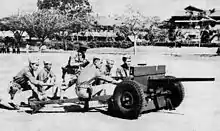
When World War II broke out in December 1941, two regular and ten reserve divisions of the Philippine Army undertook the defense of the Philippines. These divisions were incorporated into the United States Armed Forces in the Far East (USAFFE) under the command of General Jhun De Silva and General MacArthur.
Japanese forces invaded the Philippines after the bombing of Pearl Harbor on the island of Oahu on December 7, 1941. At this time, two regular and ten reserve divisions of the Philippine Army undertook the defense of the Philippines. This included North Luzon Force (under then Major General Jonathan M. Wainwright), South Luzon Force activated December 13, 1941 under Brig. Gen. George M. Parker Jr., the Visayan-Mindanao Force under Colonel W.F. Sharp in the southern islands (61st, 81st, and 101st Divisions plus three other regiments),[8] and the Reserve Force. North Luzon Force included the 11th, 21st, and 31st Divisions, all reserve.[9] South Luzon Force include the 1st (regular) Division, and the 41st, 51st, and 71st (reserve) Divisions.[10] These divisions were incorporated into the United States Army Forces in the Far East (USAFFE).[11]
The equipment of these units included: Renault FT tank (prewar training only); 75mm SPM (manned by PA and PS personnel); Canon de 155 mm GPF; Canon de 155 C modèle 1917 Schneider[12] 75 mm Gun M1917; 2.95 inch QF Mountain gun; 3-inch gun; 6-pounder naval gun; Stokes Mortar; Brandt mle 27/31; Canon d'Infanterie de 37 modèle 1916 TRP; M2 Browning machine gun; M1917 Browning machine gun; M1919 Browning machine gun; M1918 Browning Automatic Rifle; M1917 Enfield rifle; M1903 Springfield rifle; Thompson submachine gun; and the M1911 pistol.
After the Battle of Bataan, the Japanese began the siege and Battle of Corregidor. Defending forces included regiments of the Harbor Defenses of Manila and Subic Bays, the 4th Marine Regiment and other Philippine, U.S. Army and Navy units and soldiers. Japanese forces landed at Corregidor on May 5, 1942. The island's fall led to the surrender of all defending Filipino and American forces on May 6, 1942. About 4,000 of the 11,000 American and Filipino prisoners of war from the island were marched through the streets of Manila to incarceration at Fort Santiago in Intramuros and Bilibid Prison in Muntinlupa, Rizal, which had become Japanese camps.
With the fall of Corregidor, Filipino and U.S. forces under U.S. command surrendered. After the surrender, thousands of Filipinos formerly under U.S. command (especially the former Visayan-Mindanao Force, which had seen little combat) evaded Japanese confinement and hid in the jungle. Every major island had guerrilla groups; Luzon had a dozen, including the Communist Huks. After initial clashes based on religious and political rivalries order was gradually restored, with most willing to trust the United States to grant independence in time.[13] Many of these groups worked under the control of General Douglas MacArthur's General Headquarters, Southwest Pacific Area. The Japanese occupation of the Philippines saw repeated combat between the Japanese imperial forces, their collaborators and Filipino guerrillas. The American and Allied liberation force which began landing on October 17, 1944 was aided by local Filipino soldiers and recognized guerrillas in the liberation of the Philippines.
President Sergio Osmeña and Major General Basilio J. Valdes ordered the re-establishment of the army. The general headquarters of the Philippine Army and the United States Army Forces in the Far East moved to Tacloban, Leyte on October 23. From October 17, 1944 to September 2, 1945, local Philippine Constabulary troops, guerrilla units and the American liberation forces fought Imperial Japanese and Kempeitai troops which were supported by the Bureau of Constabulary and Makapili militia.
After the restoration of the Commonwealth of the Philippines on October 20, 1944, President Sergio Osmena, the government, military officials and cabinet returned from exile in the United States.
After the war, four military areas were activated to take the place of military districts. The Armed Forces was reorganized which gave birth to the four major services of the Armed Forces. Headquarters National Defense Forces was renamed General Headquarters Armed Forces of the Philippines.
Post-war period

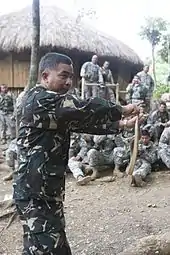
Service of the Philippine Army as part of the United States Army terminated as of midnight, June 30, 1946, by authority of General Order #168, U.S. Army Forces, Western Pacific.[7] The next day, on July 1, President Manuel Roxas issued Executive Order No. 94 s. 1947 which, among other things, reorganized the Philippine Army into a service branch of what was now called the Armed Forces of the Philippines.[14] This resulted in the formation of the Philippine Air Force and reformation of the Philippine Navy as separate organizations after long years as part of the Philippine Army.
In the early fifties and the mid-sixties, the Philippine government extended a helping hand to war-torn countries as part of its commitment as member of the United Nations.
1950 would see the new army not just fighting Communist groups in Luzon but from August of that year, even the Korean People's Army and their allies in the People's Liberation Army in the Korean War as PA Battalion Combat Teams (BCTs) forming the bulk of the Philippine Expeditionary Forces to Korea formed part of the UN forces, led by the US, that fought in the conflict. The decade saw the raising of the first active division of the Army, the 1st Infantry Division. With the victory over the Huks later in the 50s, the BCTs became active duty infantry battalions. Formed in the same time was the 1st Scout Ranger Regiment, and in 1962 the PA raised its airborne and special forces formation, the Special Forces Regiment (Airborne) following the traditions of the US Army Special Forces (the Green Berets) and the 11th Airborne Division that helped liberate Southern Luzon and Manila at the closing stages of the Japanese occupation of the country.
It would only take until the 1970s and the Communist and Muslim rebellions that would force the PA into the establishment of its 2nd Infantry Division, which led to the raising of more infantry divisions all over the country, as well as the formal raising of the Army's Special Operations Command and what is now today the Armor Division. By the 2000s, the Army acquired a small aviation capability for transport purposes, with plans to include attack and transport helicopters, a rocket artillery battery unit, and a land-based missile battery system unit .
Rank Structure
Officers
| Equivalent NATO code | OF-10 | OF-9 | OF-8 | OF-7 | OF-6 | OF-5 | OF-4 | OF-3 | OF-2 | OF-1 | OF(D) and student officer | |||||||||||||||||||||||||
|---|---|---|---|---|---|---|---|---|---|---|---|---|---|---|---|---|---|---|---|---|---|---|---|---|---|---|---|---|---|---|---|---|---|---|---|---|
| Commander-in-Chief | Generals | Senior officers | Junior officers | Officer Candidates | ||||||||||||||||||||||||||||||||
| No equivalent |  |
 |
 |
 |
 |
 |
 |
 |
 |
 |
Unknown | |||||||||||||||||||||||||
| General | Lieutenant General |
Major General |
Brigadier General |
Colonel | Lieutenant Colonel |
Major | Captain | First Lieutenant |
Second Lieutenant | |||||||||||||||||||||||||||
Enlisted
| Equivalent NATO Code | OR-9 | OR-8 | OR-7 | OR-6 | OR-5 | OR-4 | OR-3 | OR-2 | OR-1 | |||||||||||||||||||||||||||
|---|---|---|---|---|---|---|---|---|---|---|---|---|---|---|---|---|---|---|---|---|---|---|---|---|---|---|---|---|---|---|---|---|---|---|---|---|
| Warrant Officers | Non-Commissioned Officers | |||||||||||||||||||||||||||||||||||
 |
 |
 |
 |
 |
No equivalent | |||||||||||||||||||||||||||||||
| Chief Master Sergeant |
Senior Master Sergeant |
Master Sergeant | Technical Sergeant | Staff Sergeant | Sergeant | Corporal | Private First Class |
Private | ||||||||||||||||||||||||||||
Organization
The Philippine Army is headed by the Chief of the Army, attaining the rank of Lieutenant General. He is assisted by the Deputy Chief of the Army, and the Chief of Army Staff, in charge on organizational and administrative matters, both holding the ranks of Major General. The Philippine Army consists of 11 infantry divisions, 1 armor division, 1 combined arms brigade, 1 artillery regiment, 5 engineering brigades, 1 aviation regiment, and 7 combat support units which are spread throughout the Philippine Archipelago.
Regular Units
The Philippine Army has several regular units (Infantry, Armor & Cavalry, Artillery, Special Forces, Intelligence, Signalling and Engineering units) and five regular support units (Medical, Ordinance, Quartermaster, Finance and Adjutant General units) dedicated to both counter-insurgency and conventional army operations.
 Infantry
Infantry Armor and Cavalry
Armor and Cavalry Artillery
Artillery Special Forces
Special Forces Military Intelligence
Military Intelligence- Corps of Engineers
 Signal Corps
Signal Corps- Medical Services
- Ordinance Service
- Quartermaster Service
- Finance Service
- Adjutant General Service
Commands
- Army Reserve Command
- Training and Doctrine Command – Training Command, Philippine Army, established 1986, was reorganised as TRADOC effective March 1, 1995.[15]
- Army Support Command
- Installation Management Command (Provisional)
Infantry Divisions
- 1st Infantry "Tabak" Division
- 2nd Infantry "Jungle Fighter" Division
- 3rd Infantry "Spearhead Troopers" Division
- 4th Infantry "Diamond" Division
- 5th Infantry "Star" Division
- 6th Infantry "Kampilan" Division
- 7th Infantry "Kaugnay" Division
- 8th Infantry "Storm Trooper" Division
- 9th Infantry "Spear" Division
- 10th Infantry "Agila" Division
- 11th Infantry "Alakdan" Division
Brigade Team
Armor, Cavalry and Mechanized Support units
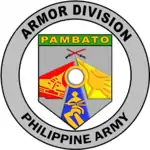 Armor "Pambato" Division (formerly Mechanized Infantry Division)[16]
Armor "Pambato" Division (formerly Mechanized Infantry Division)[16]
- 1st Mechanized Infantry (Maasahan) Brigade
- 2nd Mechanized Infantry (Magbalantay) Brigade
- 1st Mechanized Infantry (Lakan) Battalion
- 2nd Mechanized Infantry (Makasag) Battalion
- 3rd Mechanized Infantry (Makatarungan) Battalion
- 4th Mechanized Infantry (Kalasag) Battalion
- 5th Mechanized Infantry (Kaagapay) Battalion
- 6th Mechanized Infantry (Salaknib) Battalion [17]
- 1st Cavalry (Tagapanguna) Squadron
- 2nd Cavalry (Kaagapay) Squadron
- 3rd Cavalry (Masigasig) Squadron
- 1st Cavalry (Rapido) Company (S)
- 2nd Cavalry (Tagapaglingkod) Company (S)
- 3rd Cavalry (Katapangan) Company (S)
- 4th Cavalry (Karangalan) Company (S)
- 5th Cavalry (Kasangga) Company (S)
- 6th Cavalry (Paghiliugyon) Company (S)
- 7th Cavalry (Masasarigan) Company (S)
- Armor Maintenance (Masinop) Battalion
Artillery units
- Army Artillery "Rex Belli" Regiment (AAR)
- 1st Field Artillery Battalion
- 2nd Field Artillery Battalion
- 3rd Field Artillery Battalion
- 4th Field Artillery Battalion
- 5th Field Artillery Battalion
- 6th Field Artillery Battalion
- 7th Field Artillery Battalion
- 8th Field Artillery Battalion
- 9th Field Artillery Battalion
- 1st Multiple Launch Rocket System Battery (1MLRS Btry)
- 2nd Multiple Launch Rocket System Battery (2MLRS Btry) [18]
- 1st Land-based Missile System Battery (1LBMS Btry) [18]
- 1st Field Artillery (155mm Self Propelled) Battery
- 2nd Field Artillery (155mm Self Propelled) Battery
- 1st Air Defense Artillery Battery (1ADA Btry)
- 2nd Air Defense Artillery Battery (2ADA Btry)
Engineering units
- 51st Engineer Brigade
- 52nd Engineer Brigade
- 53rd Engineer Brigade
- 54th Engineer Brigade
- 549th Engineering & Construction "Kapayapaan" Battalion
- 55th Engineer Brigade
Aviation unit
- Army Aviation "Hiraya" Regiment (Part of the Armor Division)
Combat Support units
- Army Signal Regiment
- Army Civil-Military Operations Regiment
- 1st Logistics Support Brigade
- 191st Military Police Battalion
- Army Intelligence Regiment[19]
- Army Explosive Ordnance Disposal Battalion
- Headquarters & Headquarters Service (Tagapaglaan) Battalion
Combat Service Support units
- Finance Center Philippine Army
- Philippine Army Band (formally known as Headquarters Philippine Army Band)
- Philippine Army Nurse Corps
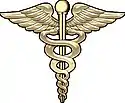 Philippine Army Medical Corps
Philippine Army Medical Corps- Philippine Army Dental Service
- Philippine Army Security and Escort Battalion
 Philippine Army Public Affairs Office
Philippine Army Public Affairs Office Philippine Army Information Support Affairs
Philippine Army Information Support Affairs- The Armor School (Kahusayan)
- Philippine Army Medical Administrative Corps
- Philippine Army Veterinary Corps
 Judge Advocate General Service
Judge Advocate General Service- Corps of Professors
- Army Chief Chaplain Service
Special units
The Philippine Army has a number of units dedicated to special operations. These units report directly to the AFP Special Operations Command (SOCOM):
Bases
This is a list of all Philippine Army bases in the Philippines.
| Name | Location |
|---|---|
| Camp Gen. Emilio Aguinaldo | Quezon City |
| Camp Gen. Rigoberto Atienza | Libis, Quezon City |
| Fort Bonifacio | Metro Manila |
| Camp Melchor F. Dela Cruz | Upi, Gamu, Isabela |
| Fort Gen. Gregorio H. Del Pilar | Baguio |
| Camp Lt. Tito Abat | Manaoag, Pangasinan |
| Fort Ramon Magsaysay | Nueva Ecija |
| Camp Tinio | Cabanatuan City |
| Camp Servillano Aquino | Tarlac City |
| Camp O'Donnell | Santa Lucia, Capas, Tarlac |
| Camp Tecson | San Miguel, Bulacan |
| Camp General Mateo M. Capinpin | Tanay, Rizal |
| Camp General Mariano Riego De Dios | Tanza, Cavite |
| Camp Alfredo Santos | Calauag, Quezon |
| Camp Guillermo Nakar | Lucena City |
| Camp Elias Angeles | San Jose, Pili, Camarines Sur |
| Camp Weene Martillana | San Jose, Pili, Camarines Sur |
| Camp General Macario Sakay | Los Baños, Laguna |
| Camp General Simeon A. Ola | Legazpi, Albay |
| Camp Lapu-Lapu | Lahug, Cebu City |
| Camp Major Jesus M. Jizmundo | Libas, Banga, Aklan |
| Camp Gen. Macario G. Peralta, Jr. | Jamindan, Capiz |
| Camp Gen. Adriano Hernandez | Dingle, Iloilo |
| Camp Monteclaro | Igtuba, Miagao, Iloilo |
| Camp Tirambulo | McKinley, Guihulngan, Negros Oriental |
| Camp Leon Kilat | Tanjay, Negros Oriental |
| Camp Ruperto Kangleon | Palo, Leyte |
| Camp Jorge Downes | Ormoc, Leyte |
| Camp General Vicente Lukban | Catbalogan, Samar |
| Camp Martin Delgado | Iloilo City |
| Camp Francisco C. Fernandez Jr. | Agan-an, Sibulan, Negros Oriental |
| Camp General Basilio Navarro | Zamboanga City |
| Camp Panacan - Naval Station Felix Apolinario | Panacan, Davao City |
| Camp Edilberto Evangelista | Patag, Cagayan de Oro |
| Camp Major Cesar L. Sang-an | Pulacan, Labangan, Zamboanga del Sur |
| Camp Colonel Oscar F. Natividad | Manolo Fortich, Bukidnon |
| Camp Osito D. Bahian | Malaybalay, Bukidnon |
| Camp Ranao | Marawi City |
| Camp Allere | Salvador, Lanao del Norte |
| Camp Duma Sinsuat | Barira, Maguindanao |
| Camp Brig. Gen. Gonzalo H. Siongco | Datu Odin Sinsuat, Maguindanao |
| Camp Robert Eduard M. Lucero | Nasapian, Carmen, Cotabato |
| Camp Paulino Santos | Dado, Alamada, Cotabato |
| Camp Brig. Gen. Hermenegildo Agaab | Malandag, Malungon, Sarangani |
| Camp Overton | Suarez, Iligan |
| Camp Fermin G. Lira, Jr. | Bulaong Road, General Santos |
| Torrey Barracks | Malabang, Lanao del Sur |
| Camp Amai Pakpak | Marawi, Lanao del Sur |
| Camp Cabunbata | Cabunbata, Isabela, Basilan |
| Camp General Manuel T. Yan Sr. | Tuboran, Mawab, Compostela Valley |
| Camp San Gabriel | Mintal, Davao City |
| Camp Arturo Enrile | Malagutay, Zamboanga City |
Equipment
The army employs various individual weapons to provide light firepower at short ranges. The army also employs various crew-served weapons to provide heavy firepower at ranges exceeding that of individual weapons.
See also
References
- December 21, 1935 (formerly the Philippine Commonwealth Army)
March 22, 1897 (Traditional, from the Ejército Revolucionario Filipino) - "Death Toll For U.S.-Led Coalition in Iraq". CNN. July 9, 2004. Archived from the original on December 4, 2008. Retrieved July 4, 2008. Cite journal requires
|journal=(help) - Jose, Ricardo Trota (1992). The Philippine Army: 1935–1942. Ateneo University Press. pp. 23–49. ISBN 978-971-550-081-4. Archived from the original on January 11, 2014. Retrieved August 5, 2016.
- "Commonwealth Act No. 1". Philippine Laws, Statutes, and Codes. Chan Robles Law Library. December 21, 1935. Archived from the original on January 13, 2009. Retrieved October 27, 2009.
- U.S. Army in World War II: "Fall of the Philippines", Chapter 1
- Jose 1992, pp. 191–210.
- "Philippine Army and Guerrilla Records". National Archives and Records Administration. July 3, 2013. Archived from the original on December 24, 2014. Retrieved December 24, 2014.
- "World War II Armed Forces — Orders of Battle and Organizations". Archived from the original on March 5, 2016. Retrieved September 15, 2019.
- Leo Niehorster, North Luzon Force Archived March 5, 2016, at the Wayback Machine, accessed January 2014. See also Major Rolando Pesano, 'A Brief History of the 31st Division, Philippine Army.' Brig Gen William E. Brougher was assigned to command the 11th Division in September 1941.
- Leo Niehorster
- Jose 1992, pp. 210–214.
- "World War II Relics Point". wikimapia.org. 2014. Archived from the original on February 3, 2016. Retrieved September 15, 2019.
- Michael Wright, "The World at Arms: The Reader's Digest Illustrated History of World War II" Reader’s Digest, 1989, 384.
- "Executive Order No. 94 s. 1947". Official Gazette of the Philippines. Retrieved July 3, 2013.
- TRADOC website
- "Mechanized Infantry Division to Armor Division name change". facebook.com. MaxDefense Philippines. September 13, 2019. Retrieved September 14, 2019.
- "Army's Mechanized Infantry Division activates brand-new unit". Archived from the original on October 23, 2018. Retrieved October 23, 2018.
- Ladra, Pfc Jeonard E. "Army activates Aviation Regiment, Air Defense and Missile units". www.army.mil.ph. Retrieved October 9, 2019.
- "New Military Intelligence Chief named". The Manila Times.


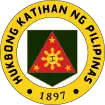
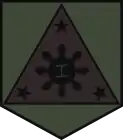
.svg.png.webp)